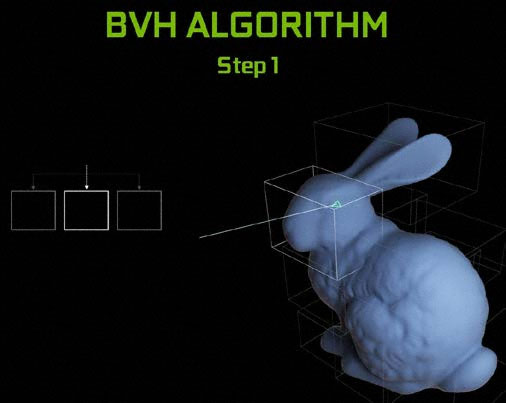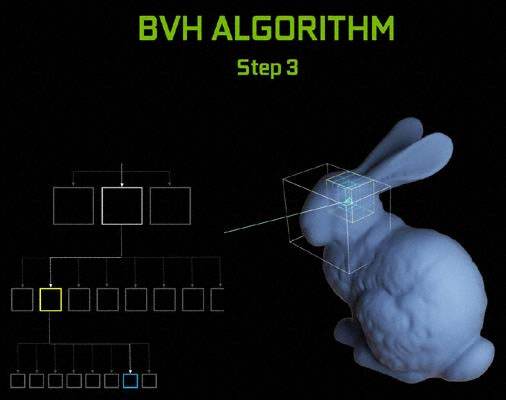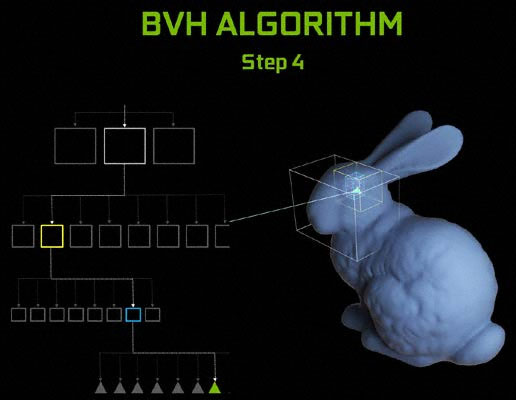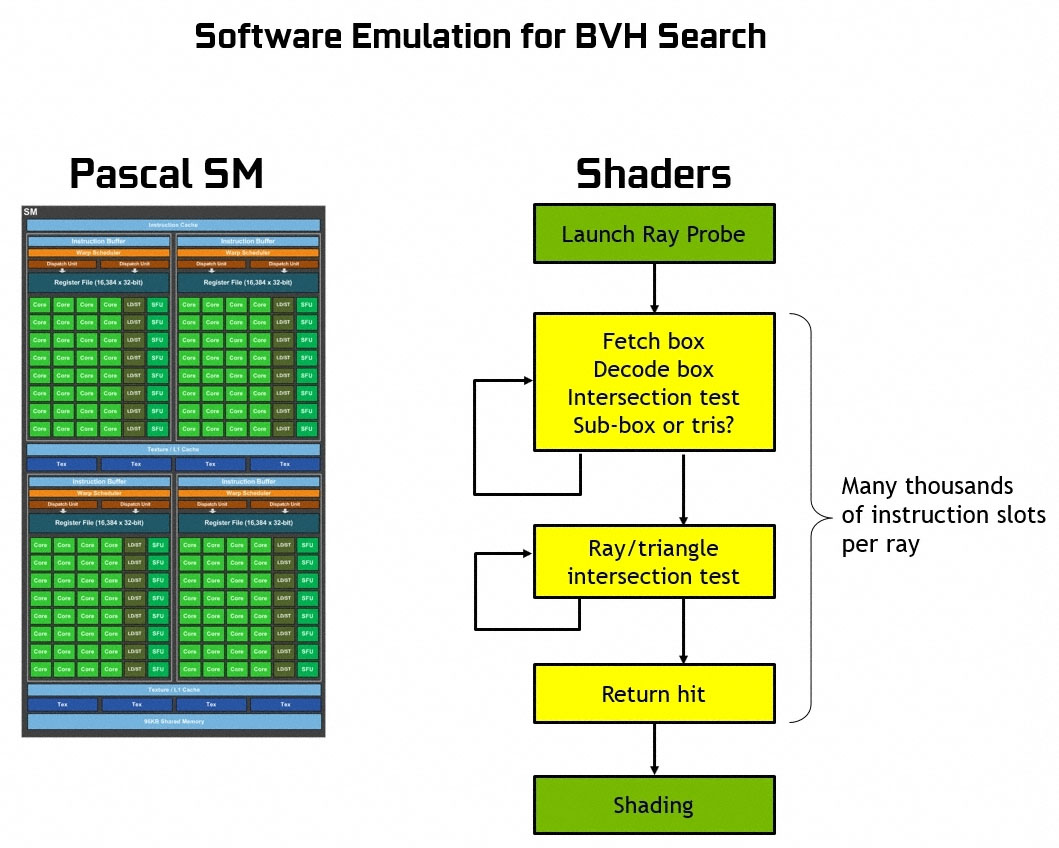Nvidia’s Turing Architecture Explored: Inside the GeForce RTX 2080
Hybrid Ray Tracing in Real-Time
Beyond the scope of anything that Volta touched, and arguably the most promising chapter in Turing’s story, is the RT core bolted to the bottom of each SM in TU102. Nvidia’s RT cores are essentially fixed-function accelerators for Bounding Volume Hierarchy (BVH) traversal and triangle intersection evaluation. Both operations are essential to the ray tracing algorithm. For more background about ray tracing and why it’s so visually appealing, see our feature: What is Ray Tracing and Why Do You Want it in Your GPU?




In short, BVHs form boxes of geometry in a given scene. These boxes help narrow down the location of triangles intersecting rays through a tree structure. Each time a triangle is found to be in a box, that box is subdivided into more boxes until the final box can be divided into triangles. Without BVHs, an algorithm would be forced to search through the entire scene, burning tons of cycles testing every triangle for an intersection.
Running this algorithm today is entirely possible using the Microsoft D3D12 Raytracing Fallback Layer APIs, which use compute shaders to emulate DirectX Raytracing on devices without native support (and redirect to DXR when driver support is identified). On a Pascal-based GPU, for instance, the BVH scan happens on programmable cores, which fetch each box, decode it, test for an intersection, and determine if there’s a sub-box or triangles inside. The process iterates until triangles are found, at which point they’re tested for intersection with the ray. As you might imagine, this operation is very expensive to run in software, preventing real-time ray tracing from running smoothly on today’s graphics processors.
By creating fixed-function accelerators for the box and triangle intersection steps, the SM casts a ray into the scene using a ray generation shader and hands off acceleration structure traversal to the fixed-function RT core. All of the intersection evaluation happens much more quickly as a result, and the SM’s other resources are freed up for shading just as they would for a traditional rasterization workload.
According to Nvidia, a GeForce GTX 1080 Ti can cast about 1.1 billion rays per second in software using its CUDA cores capable of 11.3 FP32 TFLOPs. In comparison, GeForce RTX 2080 Ti can cast about 10 billion rays per second using its 68 RT cores. It’s important to note that neither of those figures are based on calculated peaks like a lot of speeds and feeds. Rather, Nvidia took the geometric mean of results from several workloads to settle on its “10+ gigarays”value.
MORE: Best Graphics Cards
MORE: Desktop GPU Performance Hierarchy Table
Get Tom's Hardware's best news and in-depth reviews, straight to your inbox.
MORE: All Graphics Content
Current page: Hybrid Ray Tracing in Real-Time
Prev Page Designing for The Future: Tensor Cores and DLSS Next Page NVLink: A Bridge To…Anywhere?-
siege19 "And although veterans in the hardware field have their own opinions of what real-time ray tracing means to an immersive gaming experience, I’ve been around long enough to know that you cannot recommend hardware based only on promises of what’s to come."Reply
So wait, do I preorder or not? (kidding) -
jimmysmitty Well done article Chris. This is why I love you. Details and logical thinking based on the facts we have.Reply
Next up benchmarks. Can't wait to see if the improvements nVidia made come to fruition in performance worthy of the price. -
Lutfij Holding out with bated breath about performance metrics.Reply
Pricing seems to be off but the followup review should guide users as to it's worth! -
Krazie_Ivan i didn't expect the 2070 to be on TU106. as noted in the article, **106 has been a mid-range ($240-ish msrp) chip for a few generations... asking $500-600 for a mid-range GPU is insanity. esp since there's no way it'll have playable fps with RT "on" if the 2080ti struggles to maintain 60. DLSS is promisingly cool, but that's still not worth the MASSIVE cost increases.Reply -
jimmysmitty Reply21319910 said:i didn't expect the 2070 to be on TU106. as noted in the article, **106 has been a mid-range ($240-ish msrp) chip for a few generations... asking $500-600 for a mid-range GPU is insanity. esp since there's no way it'll have playable fps with RT "on" if the 2080ti struggles to maintain 60. DLSS is promisingly cool, but that's still not worth the MASSIVE cost increases.
It is possible that they are changing their lineup scheme. 106 might have become the low high end card and they might have something lower to replace it. This happens all the time. -
Lucky_SLS turing does seem to have the ability to pump up the fps if used right with all its features. I just hope that nvidia really made a card to power up its upcoming 4k 200hz hdr g sync monitors. wow, thats a mouthful!Reply -
anthonyinsd ooh man the jedi mind trick Nvidia played on hyperbolic gamers to get rid of thier overstock is gonna be EPIC!!! and just based on facts: 12nm gddr6 awesome new voltage regulation and to GAME only processes thats a win in my book. I mean if all you care is about is your rast score, then you should be on the hunt for a titan V, if it doesn't rast its trash lol. been 10 years since econ 101, but if you want to get rid of overstock you dont tell much about the new product till its out; then the people who thought they were smart getting the older product, now want o buy the new one too....Reply -
none12345 I see a lot of features that are seemingly designed to save compute resources and output lower image quality. With the promise that those savings will then be applied to increase image quality on the whole.Reply
I'm quite dubious about this. My worry is that some of the areas of computer graphics that need the most love, are going to get even worse. We can only hope that overall image quality goes up at the same frame rate. Rather then frame rate going up, and parts of the image getting worse.
I do not long to return to the day where different graphics cards output difference image quality at the same up front graphics settings. This was very annoying in the past. You had some cards that looked faster if you just looked at their fps numbers. But then you looked at the image quality and noticed that one was noticeably worse.
I worry that in the end we might end up in the age of blur. Where we have localized areas of shiny highly detailed objects/effects layered on top of an increasingly blurry background. -
CaptainTom I have to admit that since I have a high-refresh (non-Adaptive Sync) monitor, I am eyeing the 2080 Ti. DLSS would be nice if it was free in 1080p (and worked well), and I still don't need to worry about Gstink. But then again I have a sneaking suspicion that AMD is going to respond with 7nm Cards sooner than everyone expects, so we'll see.Reply
P.S. Guys the 650 Ti was a 106 card lol. Now a xx70 is a 106 card. Can't believe the tech press is actually ignoring the fact that Nvidia is relabeling their low-end offering as a xx70, and selling it for $600 (Halo product pricing). I swear Nvidia could get away with murder... -
mlee 2500 4nm is no longer considered a "Slight Density Improvement".Reply
Hasn't been for over a decade. It's only lumped in with 16 from a marketing standpoint becuase it's no longer the flagship lithography (7nm).



